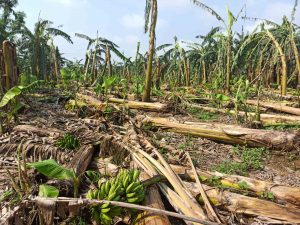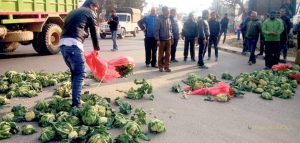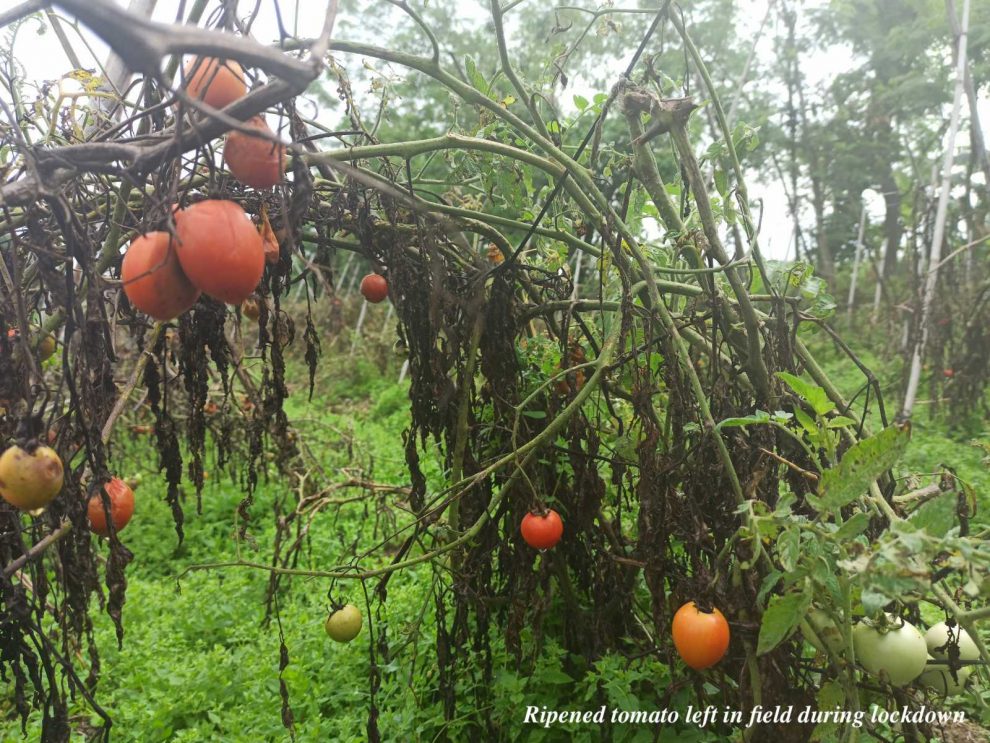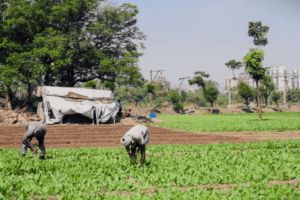The spread of COVID-19 and the resultant lockdown have already started to affect agriculture and food security in Nepal. In this blog, Ram Hari Timilsina and Suray Kant Ghimire discuss the impact of COVID-19 on different crops and agricultural enterprises in Nepal and suggest measure to overcome the crisis.
CONTEXT
Due to the fear of COVID-19 transmission, the Government of Nepal enforced lockdown and social distancing, as a result of which the entire economy, including agricultural activities, have come to an abrupt halt. Despite the government’s current decision to ease the flow of agricultural inputs the ground reality is quite different. Cooperative shops that sell agro-products at reasonable prices, agro-vet suppliers, agricultural markets, dairies, and vegetable markets are opening only sporadically. Though winter rain was beneficial to wheat cultivation, due to lack of farm machinery and the necessary human resources, the harvest of wheat and other winter crops is certain to be below par. Farmers feel devastated as they are unable to harvest the ripened crop. Poultry products, along with fruit and vegetables are hit hard by the pandemic. The current and future impact of COVID-19 on Nepal and some of the potential methods to overcome the emerging crisis are discussed in detail in this blog.
IMPACT ON AGRICULTURE AND FOOD SECURITY
One of the major effects of lockdown is visible among the farmers growing highly perishable products due to constrained transportation and market unavailability. For instance, in this peak harvesting season, banana growers in Chitwan, are panicked that if the condition persists, the fruit would ripen and rot on the plant, which could mean zero payback on their initial investment. Moreover, the recent repetitive windstorm and hail in the third week of April has fanned the flame of the farmers’ woes that have already been suffering by the forced lockdown. Standing crops like banana and maize have been severely affected. The early report suggests that a loss worth 10 million Nepali Rupees has been incurred. Also, winter maize – one of the important cereals as well as a critical component of the diet of Nepalese livestock – faced heavy damage at the same time.
 Banana damaged by wind Chainpur, Chitwan, Nepal
Banana damaged by wind Chainpur, Chitwan, Nepal
While the rainfall at this time implies hope for the new season, the complications that arose from the lockdown have put on pause any preparatory agricultural work for the upcoming season. The shortage of raw materials for the agro-based industries suggest that thousands of people could lose their jobs. Such an immense impact on the agricultural sector, on which more than 60 percent of people depend, and which contributes to more than 25 percent of the country’s gross domestic product (GDP), would aggravate poverty-related problems and lead to the collapse of the entire economy.
The prolonged effect of COVID-19 could force agricultural powerhouse countries like China, USA, and India, to impose a ban on food exports. As a result, in countries like Nepal, continuous food shortages resulting in countrywide starvation is imminent. Even at present where low supply is causing market imbalance, market prices are expected to skyrocket as soon as the economy resumes. Moreover, the rise in every cent of the dollar would correspondingly mean a rise in the challenges of imports. Therefore, COVID-19 has taught the world that every nation should have its own food security strategy at the local level so as to be resilient to outbreaks like these, and the scarcity that would accompany it. The Ministry of Agriculture in Nepal has come out with some measures to address some of these issues (see Box 1).
| Box 1: Government Initiatives (Ministry of Agriculture and Livestock Development, MoALD Nepal)
MoALD, Nepal, has declared five notable policies to combat the adversities brought about by COVID-19. These include:
However, implementing this declaration calls for combined and honest efforts from the Government of Nepal, private sectors, commodity associations, and the farmers themselves. The distribution of relief packages is not going as expected, thereby raising another critical issue for the needy. The imposed lockdown has caused a severe setback in the daily life of the vulnerable who already have a hand-to-mouth existence. The relief package, on the other hand, is misused by those who are faking their need. This scenario could re-appear while agriculture relief packages are distributed. Hence, a database built on certain criteria that can distinguish the really needy farmers is the first thing to be done. Given that this is a critical time, Nepal is presently focusing on the battle against COVID-19, so the correlated agricultural strategy has been delayed in its implementation. However, these strategies are not enough to minimize the risks brought about by the pandemic. |
NEED FOR COVID-19 IMPACT ASSESSMENT
Assessment of the impact on food security, livelihood and agricultural economy is the immediate need as it can assess the potential food crisis and lay the groundwork for sustainable solutions. The impact assessment report should become the base document for formulating relief programmes.
When the pandemic subsides, millions of Nepalese might return from abroad which would further escalate the food demand. If, around three million migrant Nepalese workers and job holders lose their jobs and are forced to return to the country, it would aggravate the already critical unemployment problem. When the country’s agricultural production fails to meet demand and this is further compounded by a shortage of agricultural inputs and restricted import, the food crisis would take on catastrophic proportions.
The breakdown of forward and backward linkages of commercial agricultural firms has led to financial imbalances in the firms which could result in the collapse of commercial agriculture. The banking system is also likely to be affected as farmers are unable to repay loans. As the risk of investment recovery in agriculture and the tourism business grows, financial institutions that are less flexible to such risks and uncertainty may even go bankrupt. Some of the potential impacts we are currently witnessing in the country are discussed below.
Cereal crops
COVID-19 is affecting the availability of inputs such as chemical fertilizers, irrigation, pesticides, and manual labour for weeding, necessary for crops like maize and spring rice. Wheat harvesting faces complications, as most of the combine harvesters and their operators used in the past were from India. But for harvested wheat, mobility restrictions amid the lockdown means a lack of access to any potential market. The aftermath surrounding the lockdown suggests seed and fertilizer scarcity for the upcoming season. The prevailing scenario urges the government to facilitate the wheat sale at a reasonable price along with other cereals that can be stored longer so as to limit the looming food shortage.
Most of the paddy produced in the country is exported across the southern border to India, which then is processed and re-imported in the form of refined rice packets. In this crisis, the government needs to cut off any paddy export.
Livestock
Shortage of feed and treatment facilities during the lockdown has severely reduced milk production. There has been a sharp decline in milk purchases by the dairies. Furthermore, farmers are unable to market their dairy products which has led to a movement to dump the milk on the roads. The quick fix is to coordinate and facilitate the transportation and marketing of milk by the local government. Besides, to protect the dairy business, grants based on per unit production should be given to farmers.
There are complaints about delayed payments by the Dairy Development Corporation (DDC) of Nepal scheduled every 15 days. In this dire situation, farmers should be promptly paid. Veterinary service providers, agricultural transporters, etc., must be smoothly facilitated. It is important to help set up micro-enterprises immediately, which would prioritize the production of dry meat, frozen meat, cheese, ghee, etc., from surplus.
Fruits and vegetables
Where the country’s domestic production is being left to rot on the farmers’ field, vegetable import hasn’t stopped, though the government has imposed import restrictions amid the COVID-19 lockdown. Door-to-door sales of local vegetables and fruits (like bananas) along with transport provision should be facilitated. The recent initiative of the agriculture-ambulance brought in by Province-5 of Nepal can prove to be a real lifesaver in this dire situation. Due to the history of excessive pesticide use and the fear of COVID-19 transmission, vegetable imports from India need to be discouraged.
 Vegetables thrown on road
Vegetables thrown on road
Poultry business
The self-reliant poultry business has been hit hard, time and again due to calamities such as bird flu. Chickens are being disposed of in this troubled period due to scarcity of feed. There has been news of farmers destroying eggs on the road due to lack of a market. The collapse of this enterprise would brutally affect agricultural gross domestic production (AGDP) along with the employment of tens of thousands of labour.
A reasonable grant program would help to contain this enterprise which is on the verge of bankruptcy. Furthermore, the interest and instalment payment schedule of banks should be revised. Farmers are demanding refinancing from banks in order to resume their business. Also, customs tariffs should be limited to one percent on imports of feed supplement and its raw materials; and measures to discount electricity bills are also needed.
Beekeeping
Currently, farmers are unable to move bees for grazing and the government seems to be clueless. Due to the high cost of production, domestic honey is unable to compete with foreign ones. Therefore, the current 17 percent customs tariff should be increased to safeguard the local honey market. Arrangements can be made to provide wood for beehives to the farmers on subsidy.
Emphasis on consumption of local products
Once the crisis ends, youths are more likely to return from abroad. This would be an enormous opportunity to create an environment for the youth to stay in the country. To energize youths to be agri-entrepreneurs, loan packages at subsidized rates should be provided on easy terms. Both in villages and cities, campaigns like home gardening and roof farming should be expanded as a campaign to ensure food self-sufficiency. The food scarcity can be minimized by consumption of underutilized native crops (locally known as Geetha, Chino, Kauno, Kathe Sama, Vagur, Sisno, etc.).
DEALING WITH THE IMPACT
To address the immediate, short term, and long term impact of COVID-19 on agriculture and food security, we suggest some of the following measures – to be taken by a range of stakeholders.
Utilization of local seeds
Due to the imbalance in the supply system, there will be a shortage of seeds and fertilizers for use in the coming season. Local governments should immediately bring incentive programmes that encourage farmers to use improved seeds. If the State can ensure marketing even by investing in farmers’ seed production, the current seed dependency on multinational companies would be reduced.
Bio-pesticides and fertilizers
The use of local plants to produce organic pesticides and manure from municipal waste are ways to reduce import dependency. The government has to provide subsidy in terms of seeds, fertilizers, pesticides, and fuel to the farmers for the upcoming season.
E-Extension advisory services
Even though most of the farmers are computer illiterate t they are social media literate. Therefore, farmers and agriculture experts should be brought together in one place through Information and Communication Technology. In a shortage of agricultural experts, professors and students of agriculture universities can also be involved. The newly established Agriculture and Forestry University (AFU) in Nepal mandated for teaching, research and extension should be instrumental in establishing linkage among its stakeholders.
Use of barren lands
With the increase in out-migration, the abandonment of arable land in Nepal is increasing. The fertile lands of the Terai and hills are left uncultivated because of the nefarious scheming of real estate agents. With the looming food crisis, the local government should make arrangements to use the concept of land banks to provide land to landless farmers. Currently, to overcome the food crisis, early maturing crop varieties should be identified and recommended by the agriculture offices.
Prime Minister’s Agriculture Modernization Project (PM-AMP)
Various agricultural initiatives, such as the Agricultural Perspective Plan (APP) and Project for Agriculture Commercialization and Trade (PACT), were interrupted due to different reasons. Some became entangled in corruption, partisanship, commission system, political turmoil, and bureaucracy. Schemes in the past benefitted various sectoral people except the real farmers. The ongoing PM-AMP project too isn’t untouched by controversy. However, the pandemic brings unique opportunities along with bitter challenges. The project should assist the agricultural production programmes of various super zones, zones, and blocks under the project, and the marketing of the product should also be ensured. The subsidy programme should be practical, transparent, and arrangements need to be made to increase the agricultural subsidy based on per unit production.
Increase in customs tariffs and quota on imports
To balance domestic products, the government should execute strategies to ban imports within a few years, and impose a partial quota system on commodities such as paddy, readymade packets of rice, maize, millet, mustard, tea, coffee, cardamom, ginger, wheat, barley, garlic, onion, chili, betelnut, herbs, fish, flowers, fruits, dairy products, goats, frozen meat, eggs, honey, and pulses.
CONCLUSION
Nepal has already worked through various long-term and short-term strategies, but an immediate strategy is required to overcome this dire situation and its consequences. Implementation of plans, policies and work on relief packages on such a great level will necessarily call for a strong will and high morale together with strict monitoring and discipline. If all three strata of government work in an integrated manner, bring agricultural education, research, and technology dissemination under one umbrella, and also adopt a pluralistic agricultural extension and development strategy, the famine that the pandemic threatens to deliver can be avoided. In this hour of great need there is no excuse for any negligence, excuse, or procrastination because earlier calamities like floods, cold waves, drought, earthquake, hurricane, heatwave, and blockade are nowhere like COVID-19.
Thus, sustainable agricultural production, food storage, food security, and subsidies are more important than ever. Regulations on imports and exports along with the food banking system are required to protect people in this crisis. If the natural agricultural process is interrupted there will be consequences more disastrous than the virus itself. We need to act and we need to act fast – because if there’s one thing that needs continuance, its agriculture. It must never stop.
 Mr Ram Hari Timilsina is a PhD Scholar, and Assistant Professor at Agriculture and Forestry University, Nepal. He also serves as Vice-President of the Nepal Agricultural Extension Association (NAEA). (Email: rhtimilsina@afu.edu.np)
Mr Ram Hari Timilsina is a PhD Scholar, and Assistant Professor at Agriculture and Forestry University, Nepal. He also serves as Vice-President of the Nepal Agricultural Extension Association (NAEA). (Email: rhtimilsina@afu.edu.np)

Prof Surya Kant Ghimire, PhD, is the founding Registrar of Agriculture and Forestry University, Nepal. (Email: suryaghimire2003@yahoo.com)





Add Comment